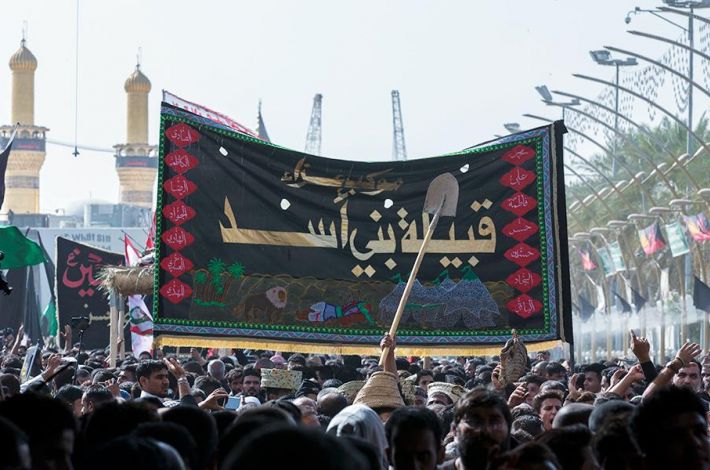As usual in every year, on the thirteenth of Muharram, the Karbalai tribes headed by the tribe of Bani Asad, commemorated the rituals of the burial of the holy martyrs' bodies that quenched the land of Karbala by their pure blood in the great tragedy of the battle of At-Taf, from Imam Al-Hussayn and his brother Aba Al-Fadl Al-Abbas (peace be upon both of them) to the rest of the martyrs.
After the prayer of Dhuhr, thousands of mourners joined the great condolences' procession; the procession of Bani Asad in the sanctuary of Sayed Jawda in southwest of Karbala, heading towards the road of Qibla of Imam Al-Hussayn (peace be upon him) up to the holy shrine then to the area between the two holy shrines, and parade is concluded at the standard bearer Aba Al-Fadl Al-Abbas (peace be upon him).
This condolences ritual is commemoration of what their ancestors did of rituals to bury the holy bodies, after remaining in the desert for three days under the burning sun, after that the heads were decapitated and the captives were taken to the Levant [Sham], and the holy bodies were left unburied. So, this is one of the important days in the hearts of the people of Karbala, because it represents the burial anniversary of Imam Al-Hussayn (peace be upon him) and all the martyrs in At-Taf.
The procession that lasted for about three hours, has started by the mourning women groups, who headed the procession, staining their heads and faces with mud, which is a ritual done by women who have lost their beloved ones. Followed by groups of tribes' men led by a symbolic coffin representing the coffin of the Master of martyrs (peace be upon him) and crowds of mourners then groups carrying pickaxes and shovels to recreate the scene of the burial of the holy bodies and to recall the incident. Slogans of loyalty and fortitude to follow the Hussayni approach, drawn by the masters of martyrs; Imam Al-Hussayn (peace be upon him) by his holy blood since one thousand and four hundred years in the holy city of Karbala.
The head of the Department of rites and Hussayni processions in Iraq and the Muslim world of the two holy shrines; Haj Riyadh Ni'mah Al-Salman, has explained to Al-Kafeel Network that: "These condolence's processions are part of the historical processions carried out by the tribe sin Karbala, noting that in this day there was the participation of some 65 processions of the Iraqi tirbes in the province."
It is to note that historians have stated that on the thirteenth of Muharram in the year 61 AH, women from the tribe of Bani Asad were drawing water from the Euphrates River, and they found corpses scattered in the desert, covered with their blood like if they were killed on the same day. The women came back to their tribe groaning and crying and then said: You are sitting in your houses, and this is Imam Al-Hussayn (peace be upon him) son of the Messenger of Allah (Allah's prayers be upon him and his holy Household), members of his family and companions massacred like sacrificed sheeps on the sand, how would you apologize to the Messenger of Allah, the Commander of the Faithful and Fatima Az-Zahra, when you will meet them? If you have missed giving support to Imam Al-Hussayn (peace be upon him), stand up now them to the pure bodies and bury them, as f you don't bury them, we will handle burying them ourselves. So men of Bani Asad came to bury the headless pure bodies, but they did not identify to whom belong each body. Suddenly, they saw a man on a horse coming their direction weeping and said: O Bani Asad, I will guide you to identify them. And after completing the burials, he introduced himself and he was Imam Ali Ibn al-Hussayn Al-Sajjad (peace be upon both of them), and since the Bani Asad tribe in Karbala, have the tradition to parade in a condolence's procession to remind the burial event that happened in this day.




















